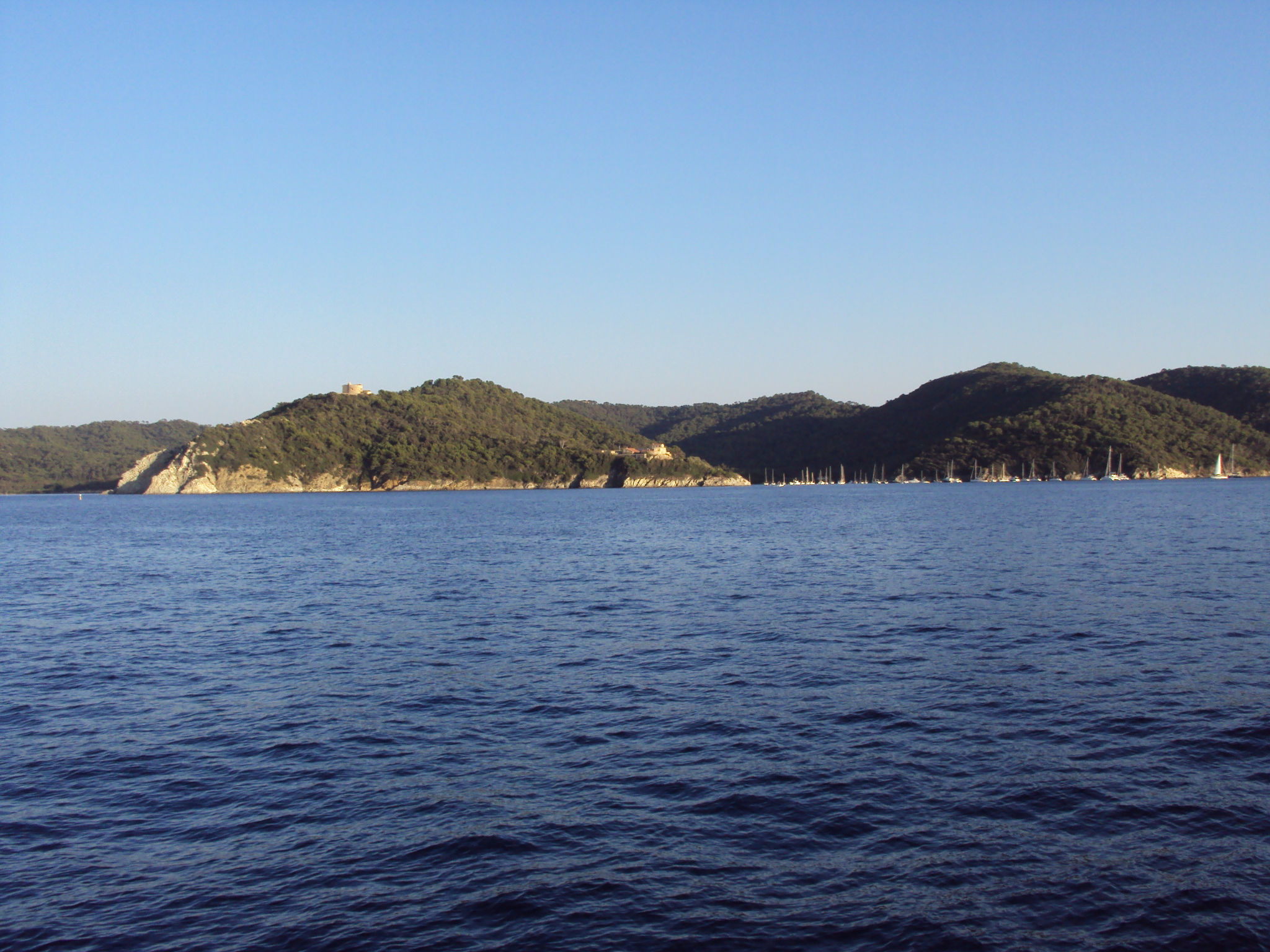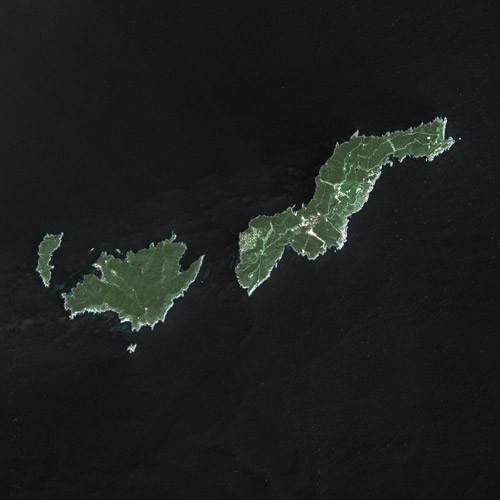Port-Cros on:
[Wikipedia]
[Google]
[Amazon]
 Port-Cros () is a French island in the
Port-Cros () is a French island in the
 The island was known as ''Messea'' (Middle Island) to the
The island was known as ''Messea'' (Middle Island) to the Site du parc national
Portail des Parc nationaux de France
*
l'Association des Amis de Port-Cros
{{authority control Îles d'Hyères Landforms of Var (department) French Riviera Mediterranean islands Hyeres
Mediterranean
The Mediterranean Sea is a sea connected to the Atlantic Ocean, surrounded by the Mediterranean Basin and almost completely enclosed by land: on the north by Western and Southern Europe and Anatolia, on the south by North Africa, and on ...
island group known as the Îles d'Hyères. It is part of the commune of Hyères
Hyères (), Provençal Occitan: ''Ieras'' in classical norm, or ''Iero'' in Mistralian norm) is a commune in the Var department in the Provence-Alpes-Côte d'Azur region in southeastern France.
The old town lies from the sea clustered arou ...
, in the department of Var in the region of Provence-Alpes-Côte d'Azur
Provence-Alpes-Côte d'Azur (; or , ; commonly shortened to PACA; en, Provence-Alps-French Riviera, italic=yes; also branded as Région Sud) is one of the eighteen administrative regions of France, the far southeastern on the mainland. Its pre ...
. The island was donated to the French government with the promise that a national park, the Port-Cros National Park, would be created on the island. This was established on 14 December 1963. The island is wide and its most elevated point is . It is .
History
 The island was known as ''Messea'' (Middle Island) to the
The island was known as ''Messea'' (Middle Island) to the ancient Greeks
Ancient Greece ( el, Ἑλλάς, Hellás) was a northeastern Mediterranean civilization, existing from the Greek Dark Ages of the 12th–9th centuries BC to the end of classical antiquity ( AD 600), that comprised a loose collection of cult ...
. Its present name derives from the small port on the island, which is cross-shaped. Roman
Roman or Romans most often refers to:
* Rome, the capital city of Italy
* Ancient Rome, Roman civilization from 8th century BC to 5th century AD
*Roman people, the people of ancient Rome
*''Epistle to the Romans'', shortened to ''Romans'', a lett ...
tombs on the island indicate that there may have been a Roman colony on the island, and coins and canals of Roman origin have also been found on the island. In the 5th century, the monastery of Lérins established a branch on Île du Levant. This foundation on Île du Levant established a branch on Port-Cros in the small valley of Notre-Dame. The monastery on Port-Cros was destroyed by Barbary pirates
The Barbary pirates, or Barbary corsairs or Ottoman corsairs, were Muslim pirates and privateers who operated from North Africa, based primarily in the ports of Salé, Rabat, Algiers, Tunis and Tripoli. This area was known in Europe ...
, who repeatedly attacked the Hyères Islands from the 10th to the 16th centuries.
In 1531, François I of France visited the Hyères, and as a result of being informed by inhabitants of the pirate attacks, charged Bertrand d'Ornesan with the task of constructing fortifications on the islands to defend them against pirates. He elevated the three islands to the status of a marquisate
A marquess (; french: marquis ), es, marqués, pt, marquês. is a nobleman of high hereditary rank in various European peerages and in those of some of their former colonies. The German language equivalent is Markgraf (margrave). A woman w ...
on 13 February 1532. In 1549, this marquisate passed to Christophe de Rocquendorf. To attract colonists, he granted asylum to common law
In law, common law (also known as judicial precedent, judge-made law, or case law) is the body of law created by judges and similar quasi-judicial tribunals by virtue of being stated in written opinions."The common law is not a brooding omniprese ...
criminals, but these caused as much disorder as the pirates they were meant to be a shield against. In 1617, the promised fortifications had not yet been built, but under the direction of Cardinal Richelieu
Armand Jean du Plessis, Duke of Richelieu (; 9 September 1585 – 4 December 1642), known as Cardinal Richelieu, was a French clergyman and statesman. He was also known as ''l'Éminence rouge'', or "the Red Eminence", a term derived from the ...
, construction began with the building of the Tour de l'Éminence, the fort of l'Estissac and the fort at Port-Man. Louis XIV of France
, house = Bourbon
, father = Louis XIII
, mother = Anne of Austria
, birth_date =
, birth_place = Château de Saint-Germain-en-Laye, Saint-Germain-en-Laye, France
, death_date =
, death_place = Palace of ...
fought against piracy in the region, but the lack of a substantial garrison caused the British to plunder Port-Cros in 1700 and to invade in 1742 before being driven out by the Jean-Frédéric Phélypeaux, Count of Maurepas.
The last marquis of the islands was Louis de Colvet, Mirabeau's father-in-law. Colvet sold the islands to Jean Joseph Barthélémy Simon de Savornin in 1783. In 1793, the British attacked Port-Cros again. Napoleon
Napoleon Bonaparte ; it, Napoleone Bonaparte, ; co, Napulione Buonaparte. (born Napoleone Buonaparte; 15 August 1769 – 5 May 1821), later known by his regnal name Napoleon I, was a French military commander and political leader wh ...
restored the defenses in 1811 and installed a garrison of veterans. After the fall of the First French Empire
The First French Empire, officially the French Republic, then the French Empire (; Latin: ) after 1809, also known as Napoleonic France, was the empire ruled by Napoleon Bonaparte, who established French hegemony over much of continental E ...
, the garrison was replaced by a company
A company, abbreviated as co., is a legal entity representing an association of people, whether natural, legal or a mixture of both, with a specific objective. Company members share a common purpose and unite to achieve specific, declared ...
of crippled soldiers. The marquisate was purchased by the French state in 1815, and changed hands a number of times before being sold to a Dr. Crotte, who tried to develop the island into a tourist resort. Some facilities for tourists, including a hotel, were built when the island was acquired by Marcel Henry and Claude Balyne. Between the interwar period
In the history of the 20th century, the interwar period lasted from 11 November 1918 to 1 September 1939 (20 years, 9 months, 21 days), the end of the First World War to the beginning of the Second World War. The interwar period was relative ...
, the island was visited by numerous figures of the artistic and literary world: Jean Paulhan
Jean Paulhan (2 December 1884 – 9 October 1968) was a French writer, literary critic and publisher, director of the literary magazine ''Nouvelle Revue Française'' (NRF) from 1925 to 1940 and from 1946 to 1968. He was a member (Seat 6, 1963–68 ...
, André Malraux
Georges André Malraux ( , ; 3 November 1901 – 23 November 1976) was a French novelist, art theorist, and Minister of Culture (France), minister of cultural affairs. Malraux's novel ''La Condition Humaine'' (Man's Fate) (1933) won the Prix Go ...
, André Gide
André Paul Guillaume Gide (; 22 November 1869 – 19 February 1951) was a French author and winner of the Nobel Prize in Literature (in 1947). Gide's career ranged from its beginnings in the symbolist movement, to the advent of anticolonialism ...
, Saint-John Perse, Paul Valéry and Jules Supervielle. Vivienne de Watteville
Vivienne Florence Beatrice de Watteville (1900–1957) was a British travel writer and adventurer, author of two books based on her experiences in East Africa in the 1920s, ''Out in the Blue'' (1927) and ''Speak to the Earth'' (1935). She is best ...
lived there from 1929, and wrote a book about her first year on the island, ''Seeds that the Wind may bring''.
During World War II
World War II or the Second World War, often abbreviated as WWII or WW2, was a world war that lasted from 1939 to 1945. It involved the World War II by country, vast majority of the world's countries—including all of the great power ...
, during the Allied invasion of Provence
Provence (, , , , ; oc, Provença or ''Prouvènço'' , ) is a geographical region and historical province of southeastern France, which extends from the left bank of the lower Rhône to the west to the Italian border to the east; it is bo ...
, the Battle of Port Cros took place on the island on 15 August 1944, in which the German
German(s) may refer to:
* Germany (of or related to)
**Germania (historical use)
* Germans, citizens of Germany, people of German ancestry, or native speakers of the German language
** For citizens of Germany, see also German nationality law
**Ge ...
garrison of 150 men fought against a force of American
American(s) may refer to:
* American, something of, from, or related to the United States of America, commonly known as the "United States" or "America"
** Americans, citizens and nationals of the United States of America
** American ancestry, pe ...
and Canadian
Canadians (french: Canadiens) are people identified with the country of Canada. This connection may be residential, legal, historical or cultural. For most Canadians, many (or all) of these connections exist and are collectively the source of ...
commandos, known as the Devil's Brigade. The island was captured by the Allies on 17 August 1944.
When Madame Henry, the owner of the island, died in 1966, she bequeathed the island to the state, with the exception of the hotel Le Manoir, which her great-nephew, Pierre Buffet, inherited. The Port-Cros National Park was created in 1963. The photographer Yann Arthus-Bertrand
Yann Arthus-Bertrand (born 13 March 1946) is a French environmentalist, activist, journalist and photographer. He has also directed films about the impact of humans on the planet. He is especially well known for his book ''Earth from Above'' (19 ...
is working on the restoration of the fort at Port-Man.References
Further reading
* ''Les îles d'Hyères'', Emile Jahandiez, Toulon, 1929 * ''Les îles d'Hyères. Fragments d'histoire'', Arles, Actes Sud-Parc National de Port-Cros, 1997.External links
*Portail des Parc nationaux de France
*
l'Association des Amis de Port-Cros
{{authority control Îles d'Hyères Landforms of Var (department) French Riviera Mediterranean islands Hyeres